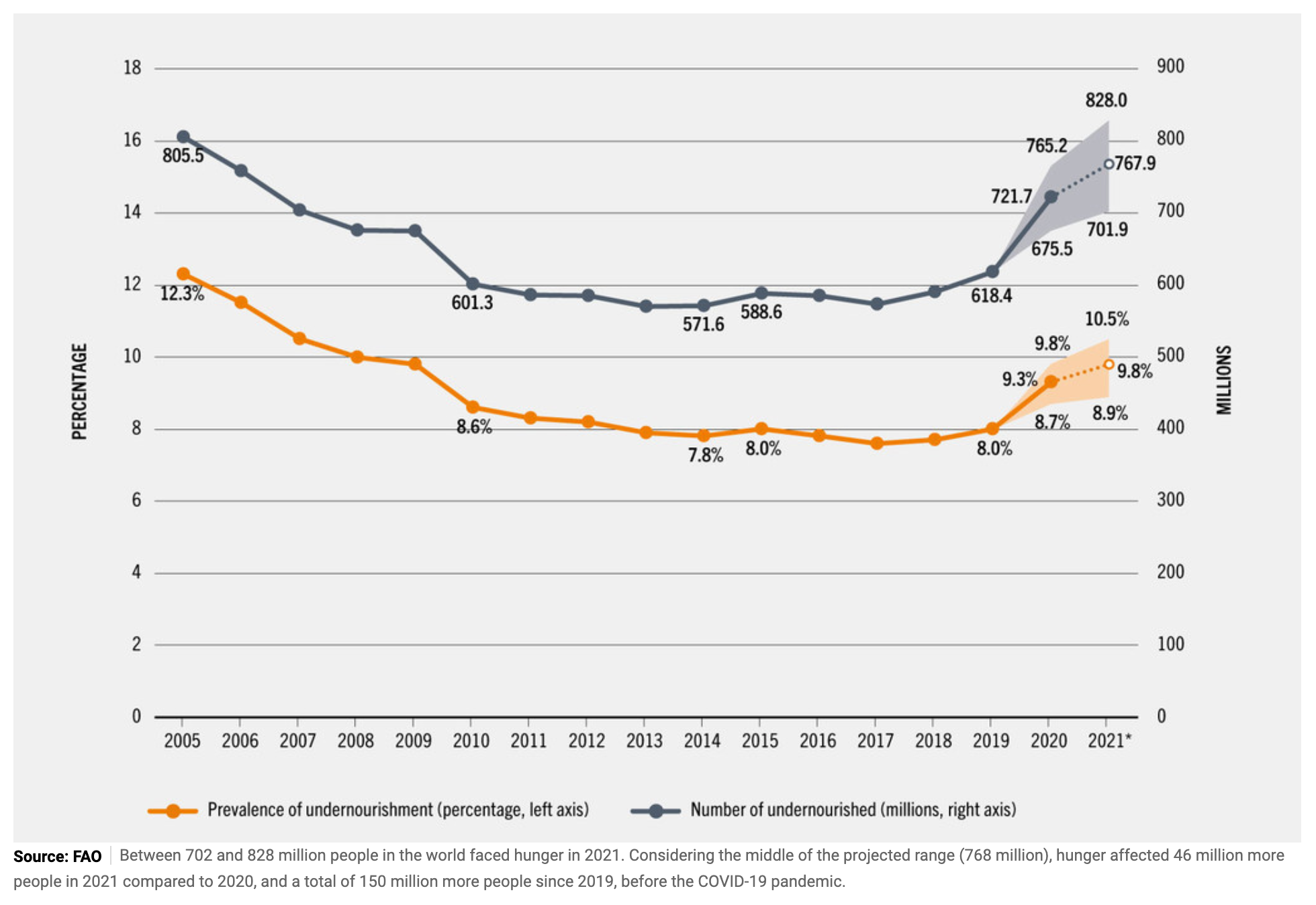GENEVA (AN) — Global hunger soared to affect almost one-in-10 people on the planet even before Russia's war in Ukraine upended the world's 'bread basket,' five United Nations agencies reported on Wednesday.
Estimates show that between 702 million and 828 million people, or 9.8% of the world population, went hungry in 2021, according to a 260-page report by the Food and Agriculture Organization, International Fund for Agricultural Development, UNICEF, World Health Organization and World Food Program.
"There is a real danger these numbers will climb even higher in the months ahead,” WFP's Executive Director David Beasley said. “The result will be global destabilization, starvation and mass migration on an unprecedented scale. We have to act today to avert this looming catastrophe.”

Rising gender gap
Beasley called on world leaders to quickly address systemic problems with global markets, including protectionism and underinvestment in developing nations. “If we had successfully threaded this needle in the past, the war in Ukraine wouldn’t be having such a disastrous global impact today," he said.
The war disrupted exports from Russia and Ukraine that supply much of the world's fuel, fertilizer and grains, causing skyrocketing food prices and adding to COVID-19 pandemic-fueled supply chain disruptions and economic woes.
By region in 2021, hunger rose in Africa, where it affected 278 million people, and in Asia, where it affected 425 million people, and in Latin America and the Caribbean, where it affected 56.5 million people — but it rose more slowly than it did from 2019 to 2020.
The gender gap made worse by the pandemic also was a factor. Last year, 31.9% of women were moderately or severely food insecure — lacking consistent access to enough food — compared with 27.6% of men globally.
By 2030, some 670 million people, or 8% of the world population, will likely still go hungry even if a global economic recovery occurs because of major setbacks in anti-poverty efforts due to a maelstrom of factors like the war, pandemic and climate change, the report finds.
That spells probable failure for one of the U.N.'s top goals — because those numbers are essentially the same as in 2015, when a high-level U.N. summit launched the 17 Sustainable Development Goals for 2030, which include working “to end poverty and hunger, in all their forms and dimensions, and to ensure that all human beings can fulfil their potential in dignity and equality and in a healthy environment.”
The world is moving backwards in efforts to eliminate hunger & malnutrition with 828 million people affected by hunger globally in 2021: UN State of Food Security and Nutrition report https://t.co/Wx7oPRGSZSpic.twitter.com/jHR2mrJPzJ
— World Health Organization (WHO) (@WHO) July 6, 2022
Call to shift 'market-distorting' subsidies
The 2021 figure shows 46 million more people went hungry than in 2020, when 9.3% of the world population was affected. And the 2020 figure reflected the additional 150 million people who went hungry largely due to the pandemic. That was a huge jump from 2019, when 8% went hungry — a number largely unchanged since 2015.
“This report repeatedly highlights the intensification of these major drivers of food insecurity and malnutrition: conflict, climate extremes and economic shocks, combined with growing inequalities,” the five U.N. agency heads jointly wrote. “The issue at stake is not whether adversities will continue to occur or not, but how we must take bolder action to build resilience against future shocks.”
Highlighted in the report is a call to shift US$630 billion a year in "market-distorting" food and agricultural subsidies that do not reach small-scale farmers and contribute to unhealthy diets and climate change. The report calls for more spending on fruits and vegetables, and less on calorie-rich staples like rice, cereals or sugar and animal-based foods like dairy and meat.
The report estimates globally that 22% of children under the age of 5 (149 million) were stunted, 6.7% (45 million) suffered from wasting, a severe form of malnutrition, and 5.7% (39 million) were overweight due to unhealthy diets in 2020.
"Every year, 11 million people die due to unhealthy diets. Rising food prices mean this will only get worse," WHO's Director-General Tedros Adhanom Ghebreyesus said. "WHO supports countries’ efforts to improve food systems through taxing unhealthy foods, subsidising healthy options, protecting children from harmful marketing, and ensuring clear nutrition labels."








